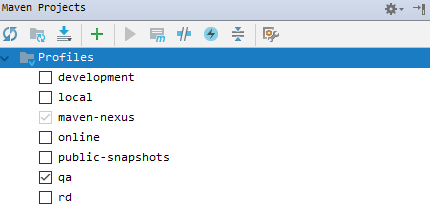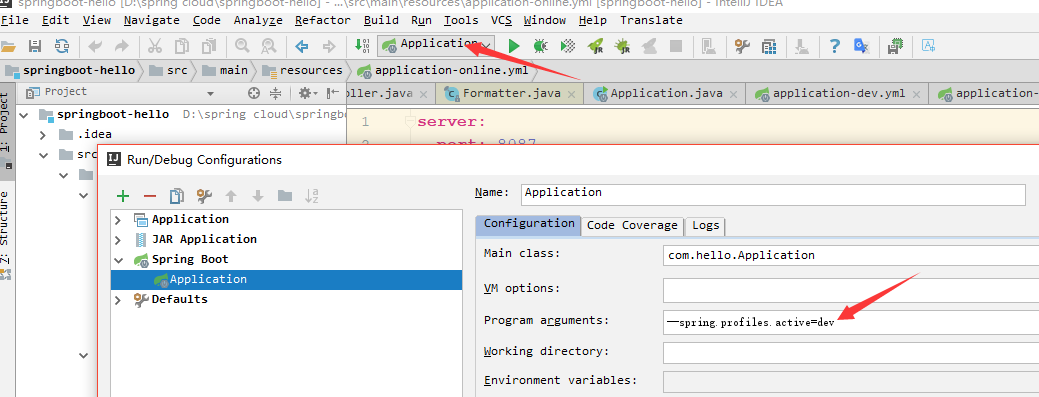SpringBoot系統列 2 - 配置檔案,多環境配置(dev,qa,online) SpringBoot系統列 1 - HelloWorld!
實現專案的多環境配置的方法有很多,比如通過在Pom.xml中配置profiles(最常見) 然後在Install專案打War包的時候,根據需求打不同環境的包,如圖:

這種配置多環境的方法在SSM框架中使用的最多,但在SpringBoot中使用最多的是在啟動SpringBoot專案的時候指定執行環境,下面也是主要描述這種配置的方法:
1.新增配置檔案
在SpringBoot的Resources目錄下建4個配置檔案 application.yml、application-dev.yml、application-qa.yml、application-online.yml
dev:開發環境
qa:測試環境
online:生產環境
然後在application.yml配置檔案中配置預設的執行環境:
spring:
profiles:
active: dev
然後在dev、qa、online中分別配置不同的配置內容,例如變更埠:
dev
server: port: 8085 servlet: context-path: /api tomcat: max-threads: 100 connection-timeout: 5000 spring: profiles: dev
qa
server: port:8086 servlet: context-path: /api tomcat: max-threads: 100 connection-timeout: 5000 spring: profiles: qa
online
server: port: 8087 servlet: context-path: /api tomcat: max-threads: 100 connection-timeout: 5000 spring: profiles: online
然後在 SpringBoot系統列 1 - HelloWorld!
import org.springframework.beans.factory.annotation.Value; import org.springframework.boot.SpringBootConfiguration; /** * 配置類 * @author XIHONGLEI * @date 2018-10-31 */ @SpringBootConfiguration public class WebConfig { @Value("${server.port}") public String port; }
然後改造一下HelloContrlller,為了區分環境,我們在請求/api/hello的時候將埠號展示出:
import com.hello.WebConfig; import org.springframework.beans.factory.annotation.Autowired; import org.springframework.web.bind.annotation.RequestMapping; import org.springframework.web.bind.annotation.RestController; @RestController public class HelloController { @Autowired private WebConfig webConfig; @RequestMapping("hello") public String hello() { return "Hello World! port:".concat(webConfig.port); } }
然後在pom.xml配置Jar包的打包配置:
<packaging>jar</packaging> <build> <finalName>spring-boot-hello</finalName> <resources> <resource> <directory>src/main/java</directory> <includes> <include>**/*.yml</include> <include>**/*.properties</include> <include>**/*.xml</include> </includes> <filtering>false</filtering> </resource> <resource> <directory>src/main/resources</directory> <includes> <include>**/*.yml</include> <include>**/*.properties</include> <include>**/*.xml</include> </includes> <filtering>false</filtering> </resource> </resources> <plugins> <plugin> <groupId>org.springframework.boot</groupId> <artifactId>spring-boot-maven-plugin</artifactId> <configuration> <fork>true</fork> <mainClass>com.hello.Application</mainClass> </configuration> <executions> <execution> <goals> <goal>repackage</goal> </goals> </execution> </executions> </plugin> <plugin> <artifactId>maven-resources-plugin</artifactId> <version>2.5</version> <configuration> <encoding>UTF-8</encoding> <useDefaultDelimiters>true</useDefaultDelimiters> </configuration> </plugin> <plugin> <groupId>org.apache.maven.plugins</groupId> <artifactId>maven-surefire-plugin</artifactId> <version>2.18.1</version> <configuration> <skipTests>true</skipTests> </configuration> </plugin> <plugin> <groupId>org.apache.maven.plugins</groupId> <artifactId>maven-compiler-plugin</artifactId> <version>2.3.2</version> <configuration> <source>1.8</source> <target>1.8</target> </configuration> </plugin> </plugins> </build>
然後Install,找打Jar包 spring-boot-hello.jar;
在Window控制檯或者Linux中可以使用java -jar spring-boot-hello.jar來啟動SpringBoot專案,然後通過在後方新增--spring.profiles.active來指定啟動SpringBoot專案時使用的環境:
# Dev環境 $ java -jar spring-boot-hello.jar --spring.profiles.active=dev # qa環境 $ java -jar spring-boot-hello.jar --spring.profiles.active=qa # online環境 $ java -jar spring-boot-hello.jar --spring.profiles.active=online
例啟動Online環境:

然後通過 http://localhost:8087/api/hello 來訪問,因為Online中配置的埠是8087

完成!
在IDEA中怎麼在執行的時候選定執行環境,可以通過配置Application的program arguments中配置執行環境:

